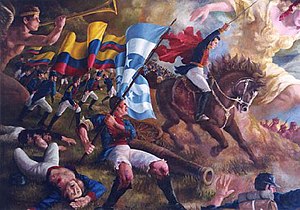
Back Batalla de Pichincha AST Batalla del Pichincha Catalan Schlacht am Pichincha German Batalo de Piĉinĉa EO Batalla de Pichincha Spanish Pichinchako gudua EU Bataille de Pichincha French Batalla de Pichincha GL Battaglia di Pichincha Italian Slag bij Pichincha Dutch
This article has multiple issues. Please help improve it or discuss these issues on the talk page. (Learn how and when to remove these messages)
|
| Battle of Pichincha | |||||||
|---|---|---|---|---|---|---|---|
| Part of Ecuadorian War of Independence | |||||||
 Representative painting of the battle of Pichincha | |||||||
| |||||||
| Belligerents | |||||||
|
| |||||||
| Commanders and leaders | |||||||
|
|
| ||||||
| Strength | |||||||
| 2,971 men | 1,894 men | ||||||
| Casualties and losses | |||||||
|
200 killed 140 wounded |
400 killed 190 wounded 1,260 prisoners | ||||||
The Battle of Pichincha took place on 24 May 1822, on the slopes of the Pichincha volcano, 3,500 meters above sea-level, right next to the city of Quito, in modern Ecuador.
The encounter, fought in the context of the Spanish American wars of independence, pitted a Patriot army under General Antonio José de Sucre against a Royalist army commanded by Field Marshal Melchor Aymerich. The defeat of the Royalist forces loyal to Spain brought about the liberation of Quito, and secured the independence of the provinces belonging to the Real Audiencia de Quito, or Presidencia de Quito, the Spanish colonial administrative jurisdiction from which the Republic of Ecuador would eventually emerge.